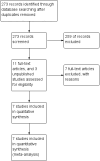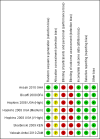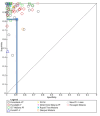Rapid diagnostic tests versus clinical diagnosis for managing people with fever in malaria endemic settings
- PMID: 24740584
- PMCID: PMC4468923
- DOI: 10.1002/14651858.CD008998.pub2
Rapid diagnostic tests versus clinical diagnosis for managing people with fever in malaria endemic settings
Abstract
Background: In 2010, the World Health Organization recommended that all patients with suspected malaria are tested for malaria before treatment. In rural African settings light microscopy is often unavailable. Diagnosis has relied on detecting fever, and most people were given antimalarial drugs presumptively. Rapid diagnostic tests (RDTs) provide a point-of-care test that may improve management, particularly of people for whom the RDT excludes the diagnosis of malaria.
Objectives: To evaluate whether introducing RDTs into algorithms for diagnosing and treating people with fever improves health outcomes, reduces antimalarial prescribing, and is safe, compared to algorithms using clinical diagnosis.
Search methods: We searched the Cochrane Infectious Disease Group Specialized Register; CENTRAL (The Cochrane Library); MEDLINE; EMBASE; CINAHL; LILACS; and the metaRegister of Controlled Trials for eligible trials up to 10 January 2014. We contacted researchers in the field and reviewed the reference lists of all included trials to identify any additional trials.
Selection criteria: Individual or cluster randomized trials (RCTs) comparing RDT-supported algorithms and algorithms using clinical diagnosis alone for diagnosing and treating people with fever living in malaria-endemic settings.
Data collection and analysis: Two authors independently applied the inclusion criteria and extracted data. We combined data from individually and cluster RCTs using the generic inverse variance method. We presented all outcomes as risk ratios (RR) with 95% confidence intervals (CIs), and assessed the quality of evidence using the GRADE approach.
Main results: We included seven trials, enrolling 17,505 people with fever or reported history of fever in this review; two individually randomized trials and five cluster randomized trials. All trials were conducted in rural African settings.In most trials the health workers diagnosing and treating malaria were nurses or clinical officers with less than one week of training in RDT supported diagnosis. Health worker prescribing adherence to RDT results was highly variable: the number of participants with a negative RDT result who received antimalarials ranged from 0% to 81%.Overall, RDT supported diagnosis had little or no effect on the number of participants remaining unwell at four to seven days after treatment (6990 participants, five trials, low quality evidence); but using RDTs reduced prescribing of antimalarials by up to three-quarters (17,287 participants, seven trials, moderate quality evidence). As would be expected, the reduction in antimalarial prescriptions was highest where health workers adherence to the RDT result was high, and where the true prevalence of malaria was lower.Using RDTs to support diagnosis did not have a consistent effect on the prescription of antibiotics, with some trials showing higher antibiotic prescribing and some showing lower prescribing in the RDT group (13,573 participants, five trials, very low quality evidence).One trial reported malaria microscopy on all enrolled patients in an area of moderate endemicity, so we could compare the number of patients in the RDT and clinical diagnosis groups that actually had microscopy confirmed malaria infection but did not receive antimalarials. No difference was detected between the two diagnostic strategies (1280 participants, one trial, low quality evidence).
Authors' conclusions: Algorithms incorporating RDTs can substantially reduce antimalarial prescribing if health workers adhere to the test results. Introducing RDTs has not been shown to improve health outcomes for patients, but adherence to the test result does not seem to result in worse clinical outcomes than presumptive treatment.Concentrating on improving the care of RDT negative patients could improve health outcomes in febrile children.
Conflict of interest statement
The authors have no known conflicts of interest.
Figures















Update of
- doi: 10.1002/14651858.CD008998
References
References to studies included in this review
Ansah 2010 GHA {published data only}
-
- Ansah EK, Narh‐Bana S, Epokor M, Akanpigbiam S, Quartey AA, Gyapong J, et al. Rapid testing for malaria in settings where microscopy is available and peripheral clinics where only presumptive treatment is available: a randomised controlled trial in Ghana. British Medical Journal 2010;340:c930. - PMC - PubMed
Bisoffi 2009 BFA {published data only}
-
- Bisoffi Z, Sirima BS, Angheben A, Lodesani C, Gobbi F, Tinto H, et al. Rapid malaria diagnostic tests vs. clinical management of malaria in rural Burkina Faso: Safety and effect on clinical decisions. A randomized trial. Tropical Medicine & International Health 2009;14(5):491‐8. - PubMed
Hopkins 2008 UGA (High) {unpublished data only}
-
- Hopkins H, Ojaku A, Yeka A, Angutoko P, Ategeka J, Okiror R, Olwoch P, Ssekabira U, Asiimwe C, Nabakooza J, Rwakimari JB, Mpanga Sebuyira L, Wabwire Mangen F, Dorsey G. Effectiveness and safety of training in fever case management with rapid diagnostic tests (RDTs) for malaria at peripheral health centers in Uganda: randomized controlled trial. Unpublished data.
Hopkins 2008 UGA (Medium) {unpublished data only}
-
- Hopkins H, Ojaku A, Yeka A, Angutoko P, Ategeka J, Okiror R, Olwoch P, Ssekabira U, Asiimwe C, Nabakooza J, Rwakimari JB, Mpanga Sebuyira L, Wabwire Mangen F, Dorsey G. Effectiveness and safety of training in fever case management with rapid diagnostic tests (RDTs) for malaria at peripheral health centers in Uganda: randomized controlled trial. Unpublished data.
Hopkins 2008 UGA (V High) {unpublished data only}
-
- Hopkins H, Ojaku A, Yeka A, Angutoko P, Ategeka J, Okiror R, Olwoch P, Ssekabira U, Asiimwe C, Nabakooza J, Rwakimari JB, Mpanga Sebuyira L, Wabwire Mangen F, Dorsey G. Effectiveness and safety of training in fever case management with rapid diagnostic tests (RDTs) for malaria at peripheral health centers in Uganda: randomized controlled trial. Unpublished data.
Skarbinski 2009 KEN {published data only}
-
- Skarbinski J, Ouma PO, Causer LM, Kariuki SK, Barnwell JW, Alaii JA, et al. Effect of malaria rapid diagnostic tests on the management of uncomplicated malaria with artemether‐lumefantrine in Kenya: a cluster randomized trial. American Journal of Tropical Medicine and Hygiene 2009;80(6):919‐26. - PubMed
Yeboah‐Antwi 2010 ZAM {published data only}
References to studies excluded from this review
Chinkhumba 2010 {published data only}
D'Acremont 2011 {published data only}
Faucher 2010 {published data only}
Kyabayinze 2010 {published data only}
Msellem 2009 {published data only}
Mubi 2011 {published data only}
Reyburn 2007 {published data only}
Additional references
Abba 2011
D'Acremont 2009
English 2009
Graz 2011
Guyatt 2008
-
- Guyatt G, Oxman AD, Akl EA, Kunz R, Vist G, Brozek J, et al. GRADE guidelines: 1. Introduction‐GRADE evidence profiles and summary of findings tables. Journal of Clinical Epidemiology 2011;64(4):383‐94. - PubMed
Higgins 2011
-
- Higgins JPT Green S (Editors). Cochrane Handbook for Systematic Reviews of Interventions; Version 5.1.0 (updated March 2011); The Cochrane Collaboration. Available from www.cochrane‐handbook.org. Chichester: John Wiley and Sons, Ltd, 2011.
Koram 2007
-
- Koram KA, Molyneux ME. When is “malaria” malaria? The different burdens of malaria infection, malaria disease, and malaria‐like illnesses. American Journal of Tropical Medicine and Hygiene 2007;77(6 Suppl):1‐5. - PubMed
Lubell 2007
-
- Lubell Y, Reyburn H, Mbakilwa H, Mwangi R, Chonya K, Whitty CJ, et al. The cost‐effectiveness of parasitologic diagnosis for malaria‐suspected patients in an era of combination therapy. American Journal of Tropical Medicine and Hygiene 2007;77(6 Suppl):128‐32. - PubMed
Murray 2008
Review Manager (RevMan) [Computer program]
-
- The Nordic Cochrane Centre, The Cochrane Collaboration. Review Manager (RevMan). Version 5.2. Copenhagen: The Nordic Cochrane Centre, The Cochrane Collaboration, 2012.
Rolland 2006
-
- Rolland E, Checchi F, Pinoges L, Balkan S, Guthmann JP, Guerin PJ. Operational response to malaria epidemics: are rapid diagnostic tests cost‐effective?. Tropical Medicine and International Health 2006;11(4):398‐408. - PubMed
Rowe 2002
-
- Rowe AK, Lama M, Onikpo F, Deming MS. Design effects and intraclass correlation coefficients from a health facility cluster survey in Benin. International Journal for Quality in Health Care 2002;14(6):421‐3. - PubMed
Shillcutt 2008
Talisuna 2007
Thiam 2011
WHO 2006
-
- World Health Organization. Towards quality testing of malaria rapid diagnostic tests: evidence and methods. Geneva: World Health Organization, 2006.
WHO 2010a
-
- World Health Organization. Guidelines for the treatment of malaria. 2nd Edition. Geneva: World Health Organization, 2010:1‐194.
WHO 2010b
-
- World Health Organization. Malaria rapid diagnostic test performance: results of the WHO product testing of malaria RDTs: Round 1 (2008). Geneva: World Health Organization, 2009:1‐4.
WHO 2012
-
- World Health Organization. World Malaria Report. Geneva: World Health Organization, 2012.
Wongsrichanalai 2007
-
- Wongsrichanalai C, Barcus MJ, Muth S, Sutamihardja A, Wernsdorfer WH. A review of malaria diagnostic tools: microscopy and rapid diagnostic test (RDT). American Journal of Tropical Medicine and Hygiene 2007;77(6 Suppl):119‐27. - PubMed
Yukich 2012
-
- Yukich JO, Bennett A, Albertini A, Incardona S, Moonga H, Chisha Z, et al. Reductions in artemisinin‐based combination therapy consumption after the nationwide scale up of routine malaria rapid diagnostic testing in Zambia. American Journal of Tropical Medicine and Hygiene 2012;87(3):437‐6. - PMC - PubMed
Zikusooka 2008
Zurovac 2008
Publication types
MeSH terms
Substances
Grants and funding
LinkOut - more resources
Full Text Sources
Other Literature Sources
Medical
Research Materials

